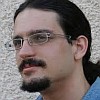| |
    
Mukul S. Bansal,
Guy Banay,
Timothy J. Harlow,
J. Peter Gogarten and
Ron Shamir. Systematic inference of highways of horizontal gene transfer in prokaryotes. In BIO, Vol. 29(5):571-579, 2013.
Keywords: duplication, explicit network, from species tree, from unrooted trees, lateral gene transfer, phylogenetic network, phylogeny, Program HiDe, Program RANGER-DTL, reconstruction.
Note: http://people.csail.mit.edu/mukul/Bansal_Highways_Bioinformatics_2013.pdf.
|
|
| |
   
Mukul S. Bansal,
Guy Banay,
J. Peter Gogarten and
Ron Shamir. Detecting Highways of Horizontal Gene Transfer. In JCB, Vol. 18(9):1087-1114, 2011.
Keywords: explicit network, from rooted trees, from species tree, lateral gene transfer, phylogenetic network, phylogeny, polynomial, reconstruction.
Note: http://people.csail.mit.edu/mukul/HighwayFull_preprint.pdf.
Toggle abstract
"In a horizontal gene transfer (HGT) event, a gene is transferred between two species that do not have an ancestor-descendant relationship. Typically, no more than a few genes are horizontally transferred between any two species. However, several studies identified pairs of species between which many different genes were horizontally transferred. Such a pair is said to be linked by a highway of gene sharing. We present a method for inferring such highways. Our method is based on the fact that the evolutionary histories of horizontally transferred genes disagree with the corresponding species phylogeny. Specifically, given a set of gene trees and a trusted rooted species tree, each gene tree is first decomposed into its constituent quartet trees and the quartets that are inconsistent with the species tree are identified. Our method finds a pair of species such that a highway between them explains the largest (normalized) fraction of inconsistent quartets. For a problem on n species and m input quartet trees, we give an efficient O(m+n 2)-time algorithm for detecting highways, which is optimal with respect to the quartets input size. An application of our method to a dataset of 1128 genes from 11 cyanobacterial species, as well as to simulated datasets, illustrates the efficacy of our method. © 2011, Mary Ann Liebert, Inc."
|
|
|
|